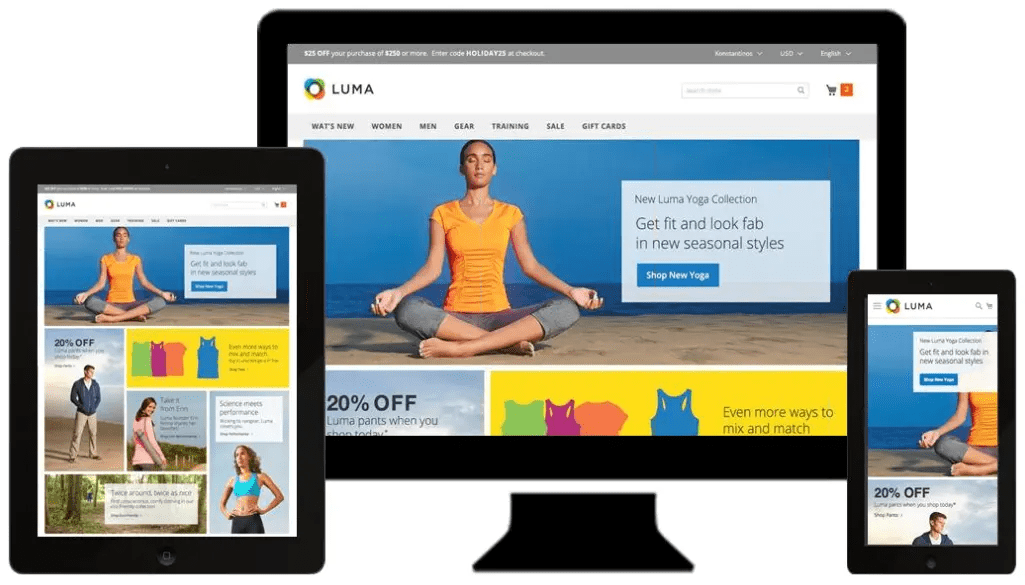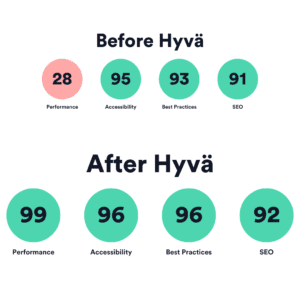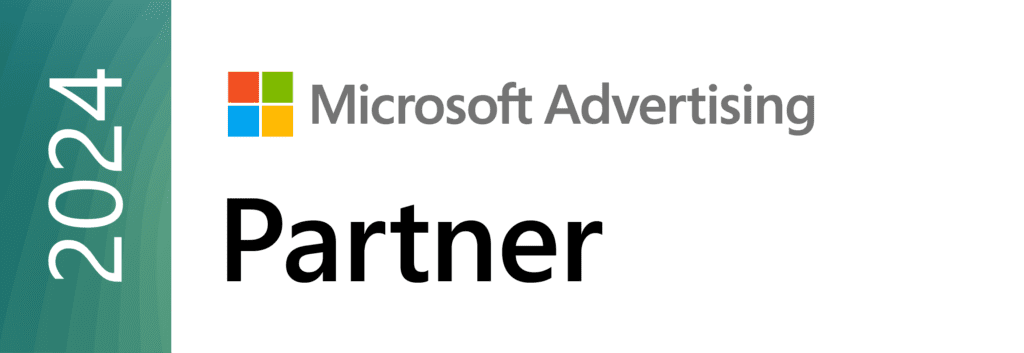When it comes to selecting the right ecommerce theme for your B2B business, the decision can significantly influence your website’s performance, user experience, and overall success.
Two of the most popular Adobe Commerce themes, Hyvä and Luma, stand out in this space, each offering distinct advantages and limitations. Choosing between them can be a challenge, particularly when catering to the unique demands of B2B ecommerce.
In this post, we’ll explore the key differences between Hyvä and Luma to help you determine which theme is best suited for your B2B ecommerce needs.
Understanding the Basics: Hyvä and Luma
Luma is the default Magento 2 theme that comes out of the box. It was introduced by Magento (now Adobe Commerce) as a foundational theme, showcasing Magento’s flexibility and potential for customisation.
Many ecommerce businesses have used Luma over the years due to its simplicity and integration with Magento’s core functionalities.

Hyvä, on the other hand, is a relatively new contender. It was built as a response to Luma’s performance limitations and complexity, particularly around frontend development.
Hyvä aims to simplify the Magento front end by reducing the heavy JavaScript reliance that Luma is known for. This reduction leads to a faster, more streamlined website that can significantly enhance user experience.
Key Considerations for B2B ecommerce
Before diving into the pros and cons of each theme, it’s essential to highlight some specific requirements for B2B ecommerce businesses. These include:
1. Performance and Scalability – B2B businesses often handle large catalogues and complex transactions, making website speed and scalability crucial
2. Customisation and Flexibility – B2B ecommerce typically involves unique customer requirements, bulk ordering, and custom workflows. A theme needs to support extensive customisation
3. User Experience (UX) – B2B buyers expect smooth, intuitive user experiences, especially as many are shifting from traditional purchasing methods to online platforms
4. Mobile Optimisation – Increasingly, B2B buyers are using mobile devices for business purchases, meaning mobile optimisation is more critical than ever
5. Cost and Maintenance – For long-term success, you must also consider the total cost of ownership, including ongoing maintenance and updates
Now that we’ve outlined the requirements, let’s compare Hyvä and Luma based on these essential criteria.
1. Performance
One of the most significant differentiators between Hyvä and Luma is performance. As a B2B ecommerce business, your website needs to load quickly and handle high traffic loads efficiently. This is where Hyvä shines.
Hyvä’s Performance
Hyvä was specifically designed to address the speed issues associated with Magento’s default themes. By reducing the reliance on JavaScript and eliminating Knockout.js, Hyvä delivers a much lighter frontend.
The result is drastically improved performance, including faster page load times and better Google Lighthouse scores. This makes it an excellent choice for B2B businesses that prioritise speed, especially for large catalogues or complex ordering processes.
Luma’s Performance
Luma, while functional, is often criticised for its relatively sluggish performance. The heavy use of JavaScript, combined with Knockout.js and RequireJS, can lead to slow load times, especially for large and complex B2B websites.
For B2B businesses handling numerous product categories and high-volume orders, this could be a significant drawback.
Winner: Hyvä
2. Customisation and Flexibility
B2B ecommerce businesses often require custom solutions to cater to their unique customer bases. Whether it’s custom pricing tiers, bulk order functionality, or specific workflows, your theme needs to allow for extensive customisation.
Hyvä’s Customisation
Hyvä offers a modern development experience with a clean and minimalistic codebase. It’s built to be developer-friendly, making it easier to customise compared to Luma.
Hyvä components also give a selection of pre-built designs for certain elements, making customisation easier and quicker.
Developers often appreciate the simplified structure, which means fewer headaches when it comes to making changes or adding new features.
The Hyvä ecosystem is also still growing, with the community actively adding in more B2B-specific modules.
Luma’s Customisation
Since Luma has been around for years, it has a much larger pool of ready-made extensions and modules that can be used for customisation. This could be an advantage for B2B businesses needing specific features right out of the box.
However, the downside is that customisation in Luma can be more time-consuming and complex due to the bloated frontend. It can take more effort for developers to implement changes or build bespoke features.
Winner: Hyvä
3. User Experience (UX)
User experience is critical in the B2B space, as it directly impacts conversion rates and customer satisfaction. B2B customers expect a fast, intuitive, and seamless experience that makes bulk ordering and repeat purchases easy.
Hyvä’s UX
Hyvä offers a much-improved user experience compared to Luma due to its superior performance and clean, modern design. Pages load faster, and the simplified frontend creates a smoother navigation experience.
The reduced complexity also means fewer potential points of failure, contributing to a more reliable website overall.
Luma’s UX
While Luma provides a functional user experience, it can feel outdated compared to modern web standards. The slower performance can negatively affect UX, particularly for users who are accustomed to the speed and fluidity of other ecommerce platforms.
Winner: Hyvä
4. Mobile Optimisation
Mobile commerce is no longer confined to B2C. More B2B buyers are using mobile devices to place orders, check inventories, or review pricing. Therefore, your B2B ecommerce site must be fully optimised for mobile users.
Hyvä’s Mobile Optimisation
Thanks to its lighter codebase and improved performance, Hyvä performs exceptionally well on mobile devices. Faster load times and smoother navigation translate to a better mobile experience for B2B customers.
Luma’s Mobile Optimisation
Luma is responsive and works well on mobile devices, but its slower performance on desktop also extends to mobile. Pages take longer to load, and the user experience may feel sluggish, which could frustrate B2B buyers who are used to fast, efficient platforms.
Winner: Hyvä
5. Cost and Maintenance
Cost is always a consideration for B2B businesses, especially when calculating long-term return on investment (ROI).
Hyvä’s Cost
Hyvä comes with an upfront cost for the theme licence, but many B2B businesses find it to be a worthwhile investment because of the reduced development time and improved performance.
Maintenance is generally simpler and faster because of the clean codebase, which can lower long-term costs.
Luma’s Cost
Luma doesn’t require any additional upfront cost since it comes with Magento by default. However, the long-term maintenance of a Luma-based site can be more expensive due to the complexity of the frontend and the effort required to optimise performance.
In addition, many of Luma’s core libraries are becoming deprecated, so it will require these to be replaced overtime, adding to the long term cost.
Finally, B2B businesses may need to invest in performance improvements, which can add to the total cost of ownership.
Winner: Hyvä
Conclusion: Which Theme is Best for B2B ecommerce?
When it comes to choosing between Hyvä and Luma for your B2B ecommerce business, Hyvä emerges as the stronger candidate for performance, user experience, and mobile optimisation.
Its clean, modern codebase and focus on speed make it ideal for B2B websites that need to handle large product catalogues and complex workflows efficiently.
While Luma has its advantages in terms of familiarity, core codebase support and lower initial cost, its performance limitations and higher long-term maintenance costs make it a less attractive option for growing B2B businesses.
Ultimately, if your priority is a fast, scalable, and future-proof B2B ecommerce site, Hyvä is the better choice.
Let’s talk
To discuss which theme is best for your ecommerce platform, get in touch to arrange a call with one of our Magento experts. Ready to get going? Book a meeting here.






